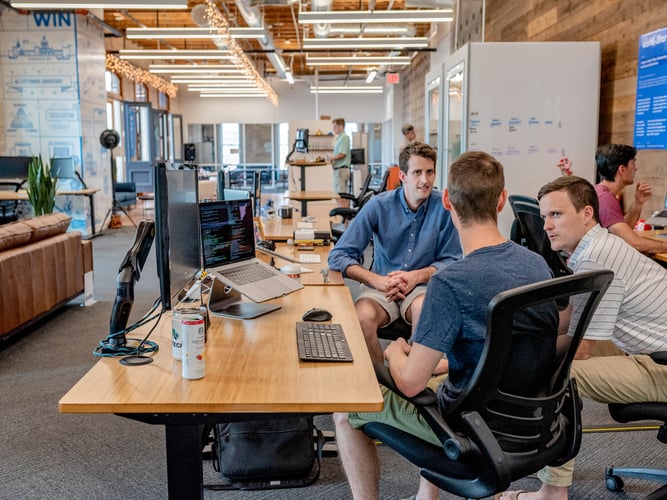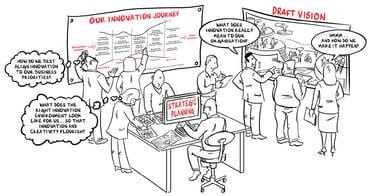Knowledge sharing and innovation
In the 1970s, Walker’s Wagon Wheel Tavern sealed its role in innovation history. Its name perfectly captured what took place there – like spokes on a wheel, people converged and the air was full of conversation on a Friday night. Ideas flew around, many of which crashed and burned. But some fused, became something bigger, gained momentum, and grew into new businesses. The tavern’s location was key – Mountain View, San Francisco, close to the emerging technology cluster of startups, big electronics firms like Fairchild Semiconductor, and the sprawling campus of Stanford University…. Silicon Valley as it was to become.
Of course, the Silicon Valley of today is different – not least because of the shift in industrial and technological priorities. The 1970s were all about the exploding new world of possibilities around microelectronics. Today, the region is a crucible for new thinking on artificial intelligence, smart connected devices, and the Internet of Things: Industry 4.0. In particular, it’s about the emerging new thinking on mobility – not just cars, trucks, and buses but a whole new industry involving new players mixing with the old, mechanical technologies meeting the virtual software and hardware combining in evermore exotic variants. Tesla, Google, and Apple are rubbing shoulders with Toyota, Daimler, Ford, and GM, bumping into NVidia, Uber, and Didi, and mingling with tiny startups like Cruise Automation and Pivotal.
Although the actors have changed, the underlying innovation dynamic remains the same. It's a classic example of what researchers William Abernathy and James Utterback called the 'fluid' phase. At this stage in the evolution of a new industry, no one is quite sure what it will look like. Only gradually will some of these big ideas begin to converge until a ‘dominant design’ crystallizes – rather than the most exotic technology, it’s more likely to be the one that fits best with what people want and value and which is technically possible.
That’s where the Wagon Wheel comes in. While the old tavern has gone (it closed in 2003), the role it played is as important as ever. Innovation is about creating value from ideas – and in the early stages of a new industry’s emergence, those ideas are widely distributed. It’s crucial to share knowledge, have conversations, explore possibilities, and make connections between different worlds – networking is the name of the game. Innovation spaces also matter, not simply as coffee shops and bars but for what they represent – meeting points where knowledge intersects.
Idea management in innovation isn’t just about the bubbling melting pot of ideas around new industries. It’s also about systematically mining the deep seams of established knowledge, digging deep into what Prahalad and Hamel famously called ‘the core competence of the corporation.’ A large part of innovation involves doing what we do but better, mobilizing and deploying our core knowledge to improve products and services and upgrade the processes that deliver those offerings.

Why is sharing and managing knowledge so important?
The challenge here might seem a long way from trying to engineer chance collisions in Silicon Valley but look more closely and you can see a version of the same issue – how to capture and mobilize ideas and extract innovation from the rich store of knowledge already held in an organization – mobilizing tacit knowledge, releasing ‘imprisoned ideas’ and unleashing internal entrepreneurship. Does the organization really know what it knows?
Take another piece of the innovation jigsaw puzzle. In a world with so much potentially useful knowledge outside the boundaries of every organization (for example, global R&D spending is now running at around US$1600 billion every year), even the biggest organization has to subscribe to Bill Joy’s, an American computer engineer’s and venture capitalist’s, famous dictum, ‘Not all the smart people work for us.’ So for the past 15 years or so, we’ve been trying to make sense of the opportunities offered by ‘open innovation,’ learning how to operate in a knowledge-rich environment.
What is knowledge management?
Every innovation opportunity depends on ‘knowledge management’ – how we construct, concentrate, assimilate, and deploy ideas to create value. Knowledge management has always been a big strategic challenge but in the past few years, the game has changed; knowledge ‘technology’ has exploded in terms of capability and diversity. We’ve seen impressive opportunities opened up by sophisticated idea management platforms - powerful new tools to use on an old problem.
How to share and manage knowledge for innovation
It’s vital to bear in mind the simple truth that knowledge is a social process. It’s a living thing carried by people, and innovation works when people talk to each other, share, combine, extend, and so on. Combining these social skills with the powerful new technologies on offer holds great promise for innovation – but we’ve got to climb a steep learning curve if we’re going to realize that promise. The good news is that innovation research offers us some powerful principles and templates for doing so. Here are some examples.
Knowledge networks
Ask most people about ‘social networking’ and they'll assume it’s something that developed in the 21st century. But it has much older roots. Back in the 1890s, sociologists like Emile Durkheim and Georg Simmel were already exploring how and why social networks and clusters form. And in the 1930s, Jacob Moreno, a famous 20th-century psychiatrist, laboriously mapped (using pencil and paper) the interactions between people, laying the foundations for today’s social network analysis toolkit and developing the source algorithms behind Facebook and Twitter.
Social networks around knowledge aren’t all the same – back in the 1970s, Mark Granovetter, an American sociologist, and professor at Stanford University, showed that they varied in terms of their connectivity. Much of the time they involve dense connections of people sharing similar and complementary information – something Granovetter called ‘strong ties’. But for new knowledge to move between networks, we need much looser links between different worlds – what he called ‘weak ties.’ That’s the challenge right now for players in the auto industry – their world of strong ties may not be enough to help them connect to the very different knowledge worlds they’ll need in the emerging mobility industry. They need the equivalent of the chance encounters offered by the Wagon Wheel bar or its 2016 equivalent!
Knowledge connectors
Making knowledge connections isn’t simply joining the dots in a mechanical fashion. Researchers have shown that we need to look at the role of brokers, who straddle the boundaries of different knowledge worlds and enable traffic to flow across them. These days, we talk knowingly about social capital and the importance of building up networks – ‘it's not what you know, but who you know’ – but this idea owes much to sociologist Ronald Burt and his research in the 1990s.
The core of Burt’s theory is that where two ‘knowledge worlds’ possess different, ‘non-redundant’ information (they know something you don’t), there’s a ‘structural hole’ between them. Brokers provide the bridge between these worlds and are central to the effective flow of knowledge between them. Today, new knowledge technologies can amplify and even automate some aspects of this knowledge-sharing process. For example, think about Facebook’s ability to find ‘friends’ you might like to connect with – and about the potential application of ‘knowledge friending’ in terms of moving knowledge around organizations and building relevant networks.
Knowledge flow
It’s also important to remember that because knowledge flows through people, their behavior matters. Tom Allen’s pioneering work in the 1970s gave us some powerful insights into the ways this happens – for example, through technological gatekeepers who are able to see the relevance of external knowledge but who also have the internal social connections to enable the right person to connect to it. In Procter and Gamble’s ‘Connect and develop’ strategy, for example, so-called ‘technology entrepreneurs’ play a key role and are credited with a number of breakthroughs and open innovation successes.
It’s also about physical connections between people; the famous ‘Allen curve’ shows that there’s a strong negative correlation between physical distance and the frequency of communication between people. Not for nothing did Steve Jobs reorganize the layout at Pixar so that it was impossible for people not to bump into each other and spark conversations. BMW uses the same principles in the underlying architecture of its futuristic R&D Centre in Munich.
Knowledge concentration
Just as in the brain, certain groups of neurons are associated with particular areas of specialization, we’re discovering the importance of ‘communities of practice’ within organizations. A concept originally developed by Etienne Wenger, a computer scientist, and Jean Lave, a cognitive anthropologist, these are groups of people with common interests who collect and share experiences about dealing with their shared problems in a variety of different contexts. These groups have deep pools of potentially valuable knowledge – as exemplified in the report by John Seeley Brown and Paul Duguid on Xerox’s experience in the world of office copiers. Its technical sales representatives worked as a community of practice, exchanging tips and tricks at informal meetings. Eventually, Xerox created the ‘Eureka’ project to allow these interactions to be shared across their global network, and this ‘knowledge store’ has saved the corporation well over US$100 million.
Knowledge architecture
There can, however, be a downside to concentrating knowledge in a community or network. As long as changes occur due to knowledge groups, things work well, and some shifts and changes can be managed effectively. But when the whole game changes – for example, when an industry like automobiles shifts into a new world of machine learning, intelligent sensors, and driverless operation – the idea network needs to change. As Rebecca Henderson and Kim Clark showed, established organizations often find it challenging to make such shifts; they need to balance the advantages of working with dominant architectures – formal groups, close ties, and concentration – with the need to preserve the capacity for new architectures. Back to weak ties and another round at the Wagon Wheel bar.
We could look at other elements, for example, knowledge transformation – how to mobilize and work with tacit knowledge; knowledge articulation – how to get at the knowledge held by employees about their jobs (what Joseph Juran famously called ‘the gold in the mine’); or knowledge assimilation – how to move new knowledge from outside to a point of active deployment (building what is called ‘absorptive capacity’).

The challenge remains the same – how can we take what we know about knowledge as a social process and embed it in the design and operation of our knowledge technology? It’s an old question – using a hammer to smash rocks or build cathedrals depends on the skills with which we use the tool.
We’ve been here before. During the 1990s, there was a surge of interest in ‘knowledge management’ - but back then we got sidetracked into discussions about databases and somehow lost sight of the bigger prize. Maybe now it's time for a reboot – Knowledge Management 2.0?









